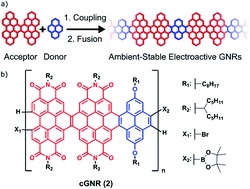Air-stable, long-length, solution-based graphene nanoribbons†
Abstract
Within the context of nanoelectronics, general strategies for the development of electronically tunable and air stable graphene nanoribbons are crucial. Previous studies towards the goal of processable nanoribbons have been complicated by ambient condition instability, insolubility arising from aggregation, or poor cyclization yield due to electron deficiency. Herein, we present a general strategy for the elongation of smaller graphene nanoribbon fragments into air-stable, easily processed, and electronically tunable nanoribbons. This strategy is facilitated by the incorporation of electron-rich donor units between electron-poor acceptor perylene diimide oligomeric units. The ribbons are processed in solution via a visible-light flow photocyclization using LEDs. The resulting long nanoribbons can be solution-cast and imaged, which are necessary characteristics for device fabrication. The ribbons become conductive after thermolysis of the pendent side-chains. The electron-accepting character of these nanoribbons in solution is reversible, and the conductivity of the thermolyzed species as a solid remains stable. This work highlights our general strategy for the mild and reliable fabrication of tunable and ambient-stable graphene nanoribbons, and charts a straightforward route for facile device incorporation.



 Please wait while we load your content...
Please wait while we load your content...